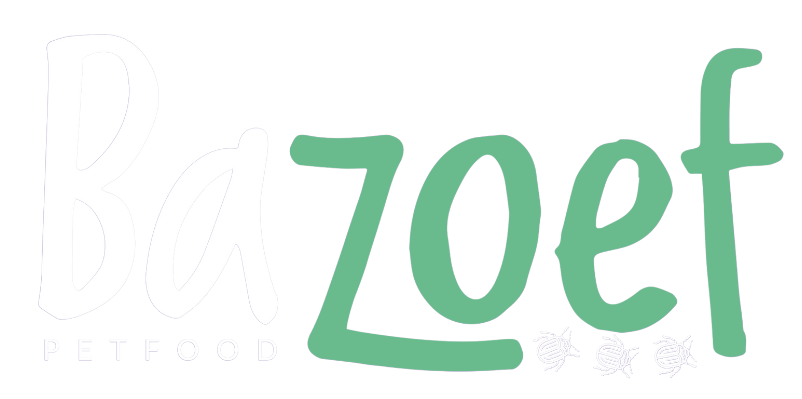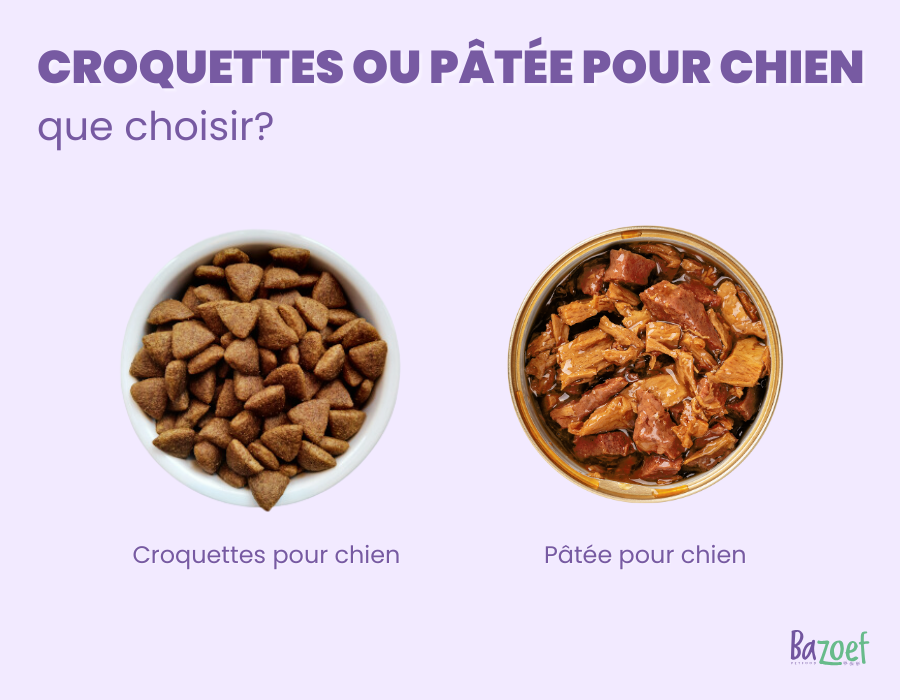When it comes to feeding their dog, many owners face a key question: should you go with kibble or wet food?
Both options have their own pros and cons, and the right choice often depends on your dog’s lifestyle, specific needs, and even your own preferences.
In this article, we’ll help you understand the key differences between kibble and wet food—so you can make an informed decision that supports your dog’s health and overall well-being.

Dry Dog Food (Kibble)
📊 Summary Table – Pros and Cons of Dry Dog Food
| Criteria | Dry Food (Kibble) |
| Easy to store | ✔️ |
| Budget-friendly | ✔️ |
| Helps reduce tartar | ✔️ |
| Wide variety of formulas | ✔️ |
| Supports hydration | ❌ |
| Highly palatable | ❌ |
| High-quality ingredients | ❌ (depends on brand/range) |
Benefits of Kibble
Kibble is one of the most popular choices among dog owners—and for good reason.
Its main advantage is convenience: it’s easy to measure, store, and serve, making it a practical option for daily feeding routines.
In addition, kibble is generally more affordable than wet food for the same nutritional quality, making it easier to feed your dog well without putting too much strain on your budget.
Another notable advantage is their mechanical effect on the teeth. Chewing kibble helps reduce tartar buildup, which can aid in preventing certain dental issues.

Enfin, les croquettes sont disponibles dans une très grande variété de formulations adaptées à l’âge, la taille, l’état de santé ou l’activité du chien, ce qui permet un choix plus ciblé.

Drawbacks of Kibble
Despite its many advantages, kibble also has some limitations. Its low moisture content (around 8–10%) can be an issue, especially for dogs that don’t drink much or suffer from kidney problems.
Poor hydration can affect long-term health, particularly kidney function and digestion.
Another key drawback is palatability: some dogs—especially picky eaters—may refuse kibble, particularly if it’s low-quality or lacks variety in taste and texture.
Lastly, lower-end kibble brands may contain animal by-products, artificial additives, or excessively high carbohydrate levels, which can harm your dog’s health over time.
That’s why it’s crucial to read ingredient labels carefully and choose a well-balanced, reputable brand.

Wet Dog Food
📊 Summary Table – Pros and Cons of Wet Dog Food
| Criteria | Wet Food |
| Easy to store (once opened) | ❌ |
| Budget-friendly | ❌ |
| Helps reduce tartar | ❌ |
| Wide variety of formulas | ✔️ |
| Supports hydration | ✔️ |
| Highly palatable | ✔️ |
| High-quality ingredients | ✔️ (depending on the brand/range) |
Benefits of Wet Food
Wet food is often seen as more appetizing than kibble. Its stronger aroma and softer texture are especially appealing to picky eaters, older dogs, or those with dental issues or reduced appetite.
It also contains a high moisture content (usually between 70% and 80%), which helps maintain hydration—particularly beneficial for dogs that don’t drink much water.
Another advantage: high-quality wet foods often provide superior nutritional value, with a high content of animal protein, fewer carbs, and no controversial additives.
They also come in a wide range of formulations tailored to your dog’s specific needs.

Drawbacks of Wet Food
While wet food is often well-liked, it does come with some downsides. It tends to be more expensive over time than kibble, largely due to its high water content and packaging.
Storage is another consideration—once opened, wet food needs to be refrigerated and consumed quickly, which can make meal management more complicated.
Additionally, its soft texture does little to support dental hygiene, unlike kibble, which helps reduce tartar buildup through chewing. Some lower-quality wet foods may also contain texturizing agents, artificial colors, or undesirable by-products.
Once again, reading the ingredient list is key—opt for brands that are transparent and use high-quality, clearly labeled ingredients.

Summary: Kibble vs. Wet Food – What Should You Choose?
📊 Comparison Table – Kibble vs. Wet Food for Dogs
| Criteria | Kibble | Wet Food |
| Shelf life | ✔️ Long-lasting at room temperature | ❌ Must be consumed quickly after opening |
| Cost | ✔️ More economical | ❌ More expensive in the long run |
| Dental health | ✔️ Helps reduce tartar buildup | ❌ No dental benefits |
| Palatability | ❌ Can vary, sometimes low | ✔️ Very appetizing |
| Water content | ❌ Very low (8–10%) | ✔️ High (70–80%) |
| Nutritional quality | ✔️ or ❌ Depends on the brand/formula | ✔️ or ❌ Depends on the brand/formula |
| Ease of use | ✔️ Easy to serve and portion | ❌ Less practical, requires refrigeration |
| For sensitive dogs | ❌ Less suited for seniors or recovering dogs | ✔️ Easier to eat and digest |
Kibble is a great fit for most healthy dogs, offering convenience, affordability, and dental benefits.
Wet food, on the other hand, is ideal for picky eaters, older dogs, sick pets, or those needing extra hydration.
In short, each option has its strengths and weaknesses: kibble is practical, budget-friendly, and supports dental health, while wet food is tastier and hydrating.
Given this, a mixed feeding approach—also known as dual feeding—can offer the best of both worlds.

Mixed Feeding: A Balanced Compromise?
Combining the Best of Both Worlds
Mixed feeding involves combining kibble and wet food in your dog’s diet—either in the same meal or by alternating between the two throughout the day.
This approach allows you to benefit from the practicality and dental support of kibble, while also offering the palatability and hydration of wet food.
It’s especially helpful for encouraging picky eaters or supporting dogs recovering from illness, all while maintaining good nutritional and digestive balance.
Important Considerations for Mixed Feeding
While mixed feeding has many advantages, it does require careful portion control to avoid excessive calorie intake.
It’s also essential to choose products that are nutritionally compatible—ideally from the same brand or product line—to ensure a well-balanced diet.
Keep in mind that not all dogs tolerate mixed feeding well, particularly those with sensitive digestion.
As always, it’s best to consult your veterinarian before switching to a mixed diet, especially if your dog has specific needs like weight issues, chronic conditions, or allergies.

Example of a Daily Mixed Feeding Plan
Here’s a sample daily mixed feeding routine (kibble + wet food) for three medium-sized, moderately active dog breeds.
This type of feeding balances energy, hydration, and taste appeal, while keeping calorie intake under control.
Quantities are for guidance only and should be adjusted based on your dog’s age, weight, food brand, and vet recommendations.
📊 Sample Mixed Rations
| Breed (typical profile) | Kibble (g/day) | Wet Food (g/day) |
| Cocker Spaniel (12 kg, 4 yrs, moderately active) | 120 g | 100 g |
| Labrador Retriever (30 kg, 6 yrs, moderately active) | 240 g | 200 g |
| Jack Russell Terrier (7 kg, 5 yrs, moderately active) | 90 g | 70 g |
ℹ️ These rations are indicative and intended for healthy adult dogs with average activity levels.
Adjust amounts based on your dog’s actual age, exercise routine, health condition, spaying/neutering status, and the energy density of the food.
Always consult your vet for a personalized feeding plan.
Conclusion
In the end, there’s no one-size-fits-all answer—the best choice depends on your dog’s profile, preferences, health, and your lifestyle.
Ideally, you should rely on your veterinarian’s advice to create a balanced, complete, and tailored diet.
Because feeding your dog well is also a way of caring for their long-term health and quality of life.



